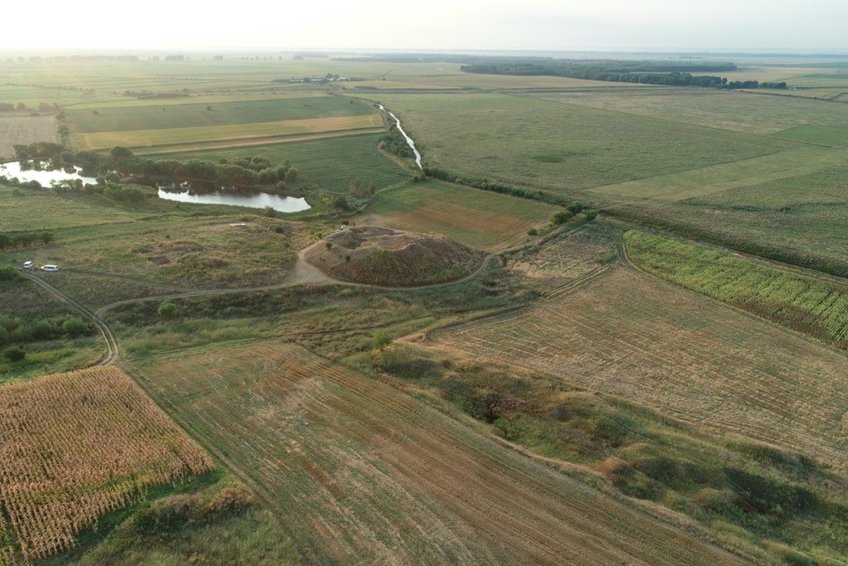Dynamic interaction zone between farmers and pastoralists
Genetic study finds early evidence for contact between late farming groups and early pastoralists in the northwestern Black Sea region
Recent archaeogenetic studies have shown that human migrations and individual mobility played a bigger role in prehistory than previously anticipated. With the movement of people, also culture, technical know-how, language and social practices were often spreading, leading to sometimes fundamental changes in lifestyle and genetic ancestry. By studying 135 individuals from the Copper and Bronze Age in southeastern Europe and the northwestern Black Sea region an international team of researchers documented significant genetic changes between 7000 and 4000 years ago, a time when contact and exchange with late farming groups enabled the economic exploration of the West Eurasian steppe belt.

Southeastern Europe played an important role in the spread of the agricultural lifestyle during the Neolithic 9000 to 8000 years ago. Expanding early farming groups introduced many cultural and technical innovations, which subsequently spread across central and western Europe. During the subsequent Copper Age, 7000 to 6000 years ago, the easy access to copper, gold and salt led to the development of numerous flourishing tell settlements in regions of today’s Bulgaria and Romania. Located at major rivers such as the Danube and the at the Black Sea, southeastern Europe thrived through contact and trade with the surrounding areas. At the same time, social hierarchies and inequalities in the distribution of wealth became visible, as evidenced in the burials of Varna, which are unparalleled in their richness in gold.
The archaeological record reports largely homogeneity in culture during this time which indicates a stable socio-political network for around 500 years. This stability is also reflected in the data presented by the new study, which shows large-scale genetic homogeneity across the wider region. Compared to the preceding local Stone Age there was very little change except a minor increase in a hunter-gatherer ancestry from remnant surrounding groups.
The beginning of a new era

Many settlement sites of the Copper Age were abandoned around 6000 years ago. The exact reasons remain unclear, but could have involved climatic deteriorations and a depletion of local resources. Instead, the settlement activity shifted further north to the forest steppe zone in regions of today’s Moldova and Ukraine where mega-sites associated with the so-called Cucuteni-Trypillia culture emerged. Here, the region around Odesa is considered an archaeological ‘melting pot’ between 6500 and 5200 years ago, with various influences from the outgoing Copper Age cultures, the northwestern Cucuteni-Trypillia culture, the abutting groups from the steppe zone to the east, but also from the geographically distant Maykop culture from the North Caucasus. The Eneolithic period (6500 to 5200 before today) was characterized by a horizon of innovations, such as wheels and wagon transportation, new metallurgical technologies, and new objects, which were spread swiftly between the North Sea and the Caucasus region.
The genetic results from the 18 ancient individuals from the Eneolithic time period mirror the heterogeneity of the archaeological findings. In addition to local genetic ancestry from the Copper Age in southeastern Europe, other genetic contributions can be traced to the forest/ steppe regions and the North Caucasus, showing that there were multiple influences coming together in this contact zone as early as ~6500 to 5400 years ago.
Previous archaeogenetic studies showed that people who lived as transitional foragers in the adjacent steppe zone around 6500 years ago carried a very different genetic profile that was, in roughly equal parts, derived from Eastern European hunter-gatherers of today’s Russia and those from the southern Caucasus region. The team of researchers could now show that this type of ancestry, so-called ‘steppe ancestry’, was already present in the Odesa region. “The biggest surprise was that we found this type of ancestry mixed in in the ancient individuals from today’s Ukraine at least 500 years earlier than expected”, says first author Sandra Penske, a PhD student at the Max Planck Institute for Evolutionary Anthropology.
“This means that besides the cultural exchange that we see in the archaeological record of the northwestern Black Sea region, there was also a genetic exchange between farming communities from the west and steppe pastoralists from the east”, adds Svend Hansen, director of the Eurasia Department of the German Archaeological Institute and senior author of the study. This time period of early contact and exchange is now clearly documented with the Eneolithic individuals from today’s Ukraine. Critically, despite this early appearance, the team found no evidence for a contribution of steppe groups to the demise of the Copper Age tell settlement, a narrative that had been postulated in the 20th century.
A mosaic of ancestries
The subsequent Early Bronze Age (5300 to 4000 years ago) is then characterized by the westward expansion of steppe pastoralists, associated with the Yamnaya culture, which emerged from the preceding horizon of contact and exchange. “Indeed, individuals who were buried in characteristic burial mounds, so-called kurgans, in today’s Bulgaria and Ukraine carried the typical steppe-related ancestry profile. However, further inland, we also found individuals who had retained the genetic signature that was already present during the Copper Age”, explains Wolfgang Haak, group leader at the Max Planck Institute for Evolutionary Anthropology and senior author of the study.
The reasons why the people associated with the Yamnaya culture and carriers of steppe ancestry suddenly expanded so drastically are not yet fully understood, but all technological and cultural prerequisites for fully nomadic pastoralism were put in place. The research team looked closely at the various Yamnaya-associated groups. “We find that all of these groups are genetically very similar, so they must have started from a small group. Interestingly, we also observe subtle contributions of local ancestry from the geographic regions, they expanded into” says Sandra Penske.
The combined transect trough time study reveals a highly dynamic picture of human prehistory in southeastern Europe and it becomes clear that nuanced archaeogenomic studies have many more chapters to offer as new data will become available.













